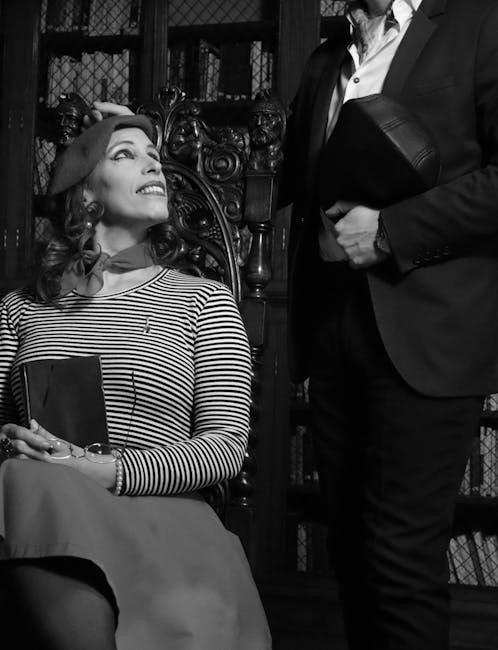
12 angry men book pdf
Twelve Angry Men by Reginald Rose is a gripping exploration of justice, morality, and human bias, set in a tense jury room. This iconic play delves into the deliberations of twelve jurors, highlighting the power of reasonable doubt and the struggle for consensus. Available as a PDF, it remains a timeless study of human nature and the legal system.
Overview of the Book
Twelve Angry Men, written by Reginald Rose, is a compelling drama that explores the deliberations of twelve jurors deciding the fate of a young man accused of murder. Originally broadcast as a teleplay in 1954, it was later adapted into a stage play and a renowned film. The story examines themes of justice, prejudice, and the power of reasonable doubt, with Juror #8 emerging as the moral backbone, challenging his peers to rethink their biases. The play’s intense dialogue and psychological depth make it a timeless classic, now widely available as a PDF for readers worldwide.
Importance of the Topic
Twelve Angry Men holds significant relevance in exploring justice, morality, and societal prejudice, making it a vital topic for discussion. The play sheds light on the importance of critical thinking and the dangers of unchecked bias, offering insights into human behavior and the legal system. Its themes of reasonable doubt and moral courage resonate deeply, making it a cornerstone of legal and dramatic studies. The availability of the PDF version ensures easy access for readers, facilitating educational discussions and reflections on its timeless lessons.
Background of the Book
Twelve Angry Men was written by Reginald Rose, inspired by his own jury experience. Originally a 1954 teleplay, it was later adapted into a stage play and film, exploring themes of justice and prejudice through the deliberations of twelve jurors.
Reginald Rose, an American screenwriter, crafted Twelve Angry Men inspired by his jury experience. Born in 1920 in Manhattan, Rose began as a TV writer, adapting his work for stage and film. His play, originally a 1954 teleplay, explores justice, morality, and prejudice, becoming a landmark in legal drama. The story’s tense jury room setting reflects Rose’s ability to probe human nature. His work remains widely studied and performed, with the PDF version of the play accessible for readers worldwide, ensuring its enduring relevance.
Original Publication and Context
Twelve Angry Men was first published as a teleplay in 1954, written for CBS’s Studio One. Its live broadcast marked a significant moment in television history, leveraging the medium’s intimate storytelling potential. Set during a tense jury deliberation, the play explored themes of justice and prejudice, resonating with audiences. The 1957 film adaptation further cemented its legacy. The original context reflects Rose’s ability to craft compelling narratives for live TV, emphasizing moral dilemmas and human conflict in a confined setting.

Plot Summary
Twelve Angry Men follows twelve jurors deliberating the fate of a young murder suspect. Juror #8 challenges the others to reconsider, leading to a unanimous ‘not guilty’ verdict.
Setting and Main Conflict
The story unfolds in a claustrophobic jury room on a sweltering summer afternoon. Twelve jurors must decide the fate of a young man accused of murder. Tensions rise as Juror #8 challenges the others to question their assumptions. The setting emphasizes isolation and intensity, with no escape from the pressure of their responsibility. The main conflict lies in Juror #8’s relentless pursuit of reasonable doubt, forcing the group to confront their biases and re-examine the evidence. This gripping dynamic drives the play’s exploration of justice and morality.
Key Events and Turning Points
The jury’s initial vote reveals near-unanimous agreement on a guilty verdict, except for Juror #8. His dissent sparks tension, prompting him to systematically challenge each piece of evidence. A turning point occurs when Juror #8 recreates the crime scene, casting doubt on the reliability of the prosecution’s case. Another pivotal moment arises when Juror #3’s personal biases are exposed, shifting the group’s perspective. These events gradually erode the majority’s confidence, leading to a final, unanimous verdict of “not guilty,” highlighting the power of perseverance and critical thinking.

Major Themes in the Book
Twelve Angry Men explores themes of justice, prejudice, and consensus, highlighting the tension between moral principles and personal biases. The play underscores the importance of critical thinking and the impact of societal influences on decision-making.
Justice and Morality
Twelve Angry Men examines the tension between justice and morality, questioning whether the legal system truly delivers fair outcomes. Juror #8’s relentless pursuit of truth highlights the importance of critical thinking and compassion in seeking justice. The play challenges the idea of morality as absolute, instead revealing how personal biases and societal influences shape perceptions of right and wrong. Through its gripping deliberations, the story underscores the necessity of empathy and integrity in upholding true justice.
Prejudice and Bias
Twelve Angry Men vividly portrays how prejudice and bias influence decision-making, even in a legal setting. The jurors’ initial votes are often swayed by personal experiences and stereotypes, such as Juror #10’s overt prejudice against people from the slums. Rose masterfully reveals how societal biases can cloud judgment, as seen in the jurors’ assumptions about the defendant’s background. The play underscores the danger of allowing prejudice to override evidence, emphasizing the importance of objective reasoning in achieving justice.
The Struggle for Consensus
Twelve Angry Men captures the intense struggle for consensus among jurors with differing opinions and backgrounds. Initially, an 11-1 vote reflects widespread agreement on guilt, but Juror #8’s persistent questioning sparks debate. The play highlights how consensus-building requires active listening, empathy, and the courage to challenge assumptions. Through tense negotiations, the jurors gradually uncover flaws in the case, illustrating the importance of collaboration and open-mindedness in reaching a just verdict. Rose’s portrayal of this process emphasizes the value of patience and critical thinking in collective decision-making.
The Concept of Reasonable Doubt
Twelve Angry Men underscores the critical role of reasonable doubt in the legal system. Juror #8’s relentless questioning introduces doubt, challenging the majority’s certainty. The play illustrates how doubt can unravel seemingly clear evidence, revealing biases and gaps in logic. Rose’s depiction of the jurors’ evolving perspectives highlights the importance of critical examination and the ethical obligation to ensure justice. The concept of reasonable doubt becomes a catalyst for moral reflection, demonstrating its power to prevent a miscarriage of justice and uphold the principle of innocence until proven guilty.

Character Analysis
Juror #8 emerges as the voice of reason, challenging prejudice and advocating for justice. Other jurors represent diverse personalities, revealing biases and conflicts that shape their decisions.
Juror #8: The Voice of Reason
Juror #8 is the moral backbone of the play, advocating for justice over judgment. Initially, he stands alone in questioning the guilty verdict, driven by a commitment to fairness. His calm demeanor and methodical approach to analyzing evidence challenge the prejudices of others. Through persistent reasoning, he plants seeds of doubt, ultimately swaying the jury. Juror #8’s courage and conviction highlight the importance of critical thinking and empathy in reaching a just decision.
Other Jurors: Their Roles and Conflicts
The other jurors in Twelve Angry Men represent diverse personalities and biases, each influencing the deliberation. Juror #3, driven by personal bitterness, struggles with forgiveness, while Juror #7 prioritizes personal gain over justice. Juror #10 reveals deep-seated prejudice, opposing Juror #8’s rational arguments. These conflicts highlight how personal experiences and biases can cloud judgment, underscoring the challenges of reaching a fair verdict in a flawed justice system.
The Dynamics of the Group
The group dynamics in Twelve Angry Men are fueled by tension and conflicting perspectives. Juror #8 challenges the majority, sparking resistance and gradual persuasion. As debates intensify, personal biases surface, revealing jurors’ backgrounds and emotions. The group evolves from chaos to cooperation, with Juror #8’s persistence inspiring critical thinking. This transformation highlights how individual voices can shift collective opinions, ultimately leading to a more just outcome.

The Jury Room Setting
The jury room in Twelve Angry Men is a confined, oppressive space with a long conference table, electric clock, and water cooler, creating tension and isolation.
Symbolism of the Jury Room
The jury room in Twelve Angry Men symbolizes confinement and tension, reflecting the jurors’ emotional struggles. The long table and chairs represent unity and division, while the clock signifies time’s pressure. The water cooler and wastebasket emphasize the room’s isolation, mirroring the jurors’ detachment from the outside world. The stark, clinical environment underscores the legal system’s formality and the gravity of their decision, heightening the drama and moral conflict as they grapple with justice, prejudice, and doubt.
Psychological Impact of the Environment
The jury room’s confined, oppressive atmosphere intensifies the psychological tension among the jurors. The lack of windows and ticking clock heighten the sense of claustrophobia and time pressure, amplifying stress and frustration. The stark, formal setting mirrors the legal system’s impersonality, while the physical layout—long table and chairs—reflects the jurors’ emotional distances and struggles for dominance. This environment fosters irritability, revealing deep-seated prejudices and personal biases, ultimately influencing the group’s dynamics and decision-making process.

Adaptations and Interpretations
Twelve Angry Men has been adapted into a 1957 film, stage plays, and modern interpretations, ensuring its timeless themes resonate across generations and diverse audiences.
The 1957 Film Adaptation
The 1957 film adaptation of Twelve Angry Men, directed by Sidney Lumet, is a landmark legal drama. Starring Henry Fonda as Juror #8, it faithfully adapts Reginald Rose’s teleplay, capturing the tense deliberations of the jury. The film maintains the play’s claustrophobic setting, emphasizing the psychological dynamics of the jurors. Its success solidified the story’s place in cinematic history, offering a powerful exploration of justice, prejudice, and consensus-building. The adaptation remains a classic, inspiring future legal dramas with its gripping portrayal of human conflict and moral courage.
Stage Play Versions
Twelve Angry Men originated as a teleplay but quickly transitioned to the stage, where it gained widespread acclaim. Reginald Rose’s adaptation for theater preserved the intense jury room dynamics, exploring themes of justice and prejudice. The play has been performed globally, with various adaptations, including all-female and mixed-gender casts. Its timeless relevance continues to resonate, making it a staple in theatrical productions and a powerful exploration of human nature and moral decision-making.
Modern Interpretations
Modern interpretations of Twelve Angry Men highlight its enduring relevance, with adaptations exploring contemporary themes like systemic prejudice and the challenges of consensus-building. The play has been reimagined with diverse casts, including all-female and mixed-gender versions, emphasizing its universal appeal. Educational institutions widely use the text to examine justice and bias, while critical editions, such as Methuen Drama’s, offer fresh insights for students and scholars. Its exploration of human nature and moral dilemmas continues to resonate in today’s sociopolitical climate.

Availability of the PDF Version
The Twelve Angry Men PDF is easily accessible online through various sources, including Google Docs, educational platforms, and literary websites. Ensure JavaScript is enabled for downloads.
Where to Download the PDF
The Twelve Angry Men PDF can be downloaded from various online platforms, including educational websites, literary archives, and document-sharing services like Google Docs. Ensure JavaScript is enabled in your browser for smooth access. Additionally, platforms like Internet Archive and Project Gutenberg offer free access to the text. Always verify the legality of the source to avoid copyright infringement. This ensures a safe and ethical way to obtain the play for academic or personal reading.
Legal and Ethical Considerations
Downloading Twelve Angry Men as a PDF requires adherence to copyright laws. Ensure the source is reputable and legally authorized to distribute the text. Many platforms offer free access, but verify permissions to avoid infringement. Reginald Rose’s estate retains rights, so reproduction or performance requires proper authorization. Ethical access supports the author’s legacy and intellectual property rights. Always prioritize legal downloading to respect the work and its creator.

Themes and Symbolism
Twelve Angry Men explores justice, morality, and prejudice, with the jury room symbolizing isolation and confrontation. Rose examines human nature and societal biases through tense deliberations and conflicting perspectives.
Social Prejudice and Its Effects
Twelve Angry Men vividly portrays how social prejudice influences decision-making, with jurors bringing personal biases into the deliberation. These biases nearly lead to a wrongful conviction, reflecting broader societal issues. The play highlights how prejudice can cloud judgment and hinder justice, emphasizing the importance of overcoming such biases. Through the jurors’ interactions, Rose illustrates the destructive power of prejudice and the need for empathy and reason in overcoming it.
Moral Courage and Conviction
Juror #8 exemplifies moral courage and conviction, standing alone against the majority to fight for justice. His unwavering commitment to questioning the evidence and challenging prejudice sparks a transformation in the jury. Through his character, Reginald Rose underscores the importance of ethical standpoints and the power of one individual to inspire change. This theme resonates universally, encouraging readers to uphold their principles even in the face of adversity.

Cultural and Legal Impact
Twelve Angry Men has profoundly influenced legal dramas, emphasizing the importance of critical thinking and justice. Its exploration of societal issues remains relevant, shaping PDF discussions globally.
Influence on Legal Dramas
Twelve Angry Men has become a cornerstone of legal dramas, inspiring countless adaptations and influencing the genre. Its realistic portrayal of jury deliberations and psychological dynamics set a new standard for courtroom stories. The play’s focus on individual perspectives and moral dilemmas has shaped modern legal dramas, emphasizing the human element within the judicial system. Its legacy continues to inspire filmmakers and writers, solidifying its impact on the evolution of legal storytelling in both film and television. The PDF version remains a vital resource for studying this influence.
Reflection of Societal Issues
Twelve Angry Men serves as a powerful reflection of societal issues, particularly the pervasive influence of prejudice and bias. The jurors’ deliberations expose deep-rooted racial, class, and generational divides, mirroring the fractures in American society. Rose’s exploration of these themes highlights how personal experiences and stereotypes can undermine justice. The play’s examination of moral courage and the struggle for fairness resonates universally, offering a stark reminder of the challenges in achieving true equality and impartiality. Its relevance endures, making it a vital commentary on human nature and societal norms.

Educational Significance
Twelve Angry Men holds significant educational value, widely used in schools and universities to teach critical thinking, justice, and morality through its gripping narrative and complex characters, fostering analytical skills and sparking discussions on societal issues.
Use in Schools and Universities
Twelve Angry Men is widely integrated into school and university curriculums, serving as a powerful tool for teaching critical thinking, ethics, and social justice. Its themes of prejudice, morality, and consensus-building resonate deeply with students, fostering meaningful discussions. The play is often used in literature, drama, and social studies classes to explore complex societal issues. Educators also employ it to teach analytical skills, encouraging students to question assumptions and evaluate evidence. Its accessibility and relevance make it a cornerstone of educational programs worldwide.
Teaching Activities and Discussions
Twelve Angry Men is a popular text for classroom instruction, fostering dynamic discussions and critical thinking. Teachers often assign mock jury deliberations, encouraging students to analyze evidence and debate perspectives. Discussions focus on themes like prejudice, morality, and justice, helping students develop empathy and argumentation skills. Reflective essays and group debates further enhance understanding, while character analyses allow exploration of individual motivations. These activities promote engagement and deeper comprehension of the play’s societal relevance and psychological depth.
Twelve Angry Men by Reginald Rose is a timeless exploration of justice, morality, and human prejudice, remaining highly relevant in contemporary discussions on fairness and societal issues.
Final Thoughts on the Book
Twelve Angry Men by Reginald Rose is a powerful exploration of justice, morality, and human prejudice. The book challenges readers to question their assumptions and reflect on the importance of empathy and critical thinking. Its intense character dynamics, particularly Juror #8’s unwavering commitment to justice, make it a compelling study of human nature. The story’s focus on reasonable doubt and consensus-building remains deeply relevant today, solidifying its place as a classic in legal and dramatic literature. Its timeless themes continue to resonate in contemporary society and educational settings.
Relevance in Contemporary Society
Twelve Angry Men remains highly relevant today, offering timeless lessons on justice, prejudice, and critical thinking. Its exploration of human biases and the legal system resonates in modern debates about fairness and equality. The play’s focus on the power of individual conviction and the dangers of groupthink continues to inspire discussions in education, law, and social justice. Its themes of moral courage and the pursuit of truth are as vital now as they were when first written, making it a enduring classic for contemporary audiences.